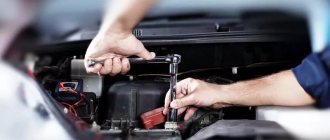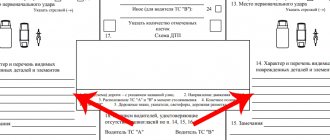Transferring the vehicle to a service station
I propose to start the conversation with how to hand over a car to auto mechanics. So, the claim about the occurrence of an insured event was considered, the damage was assessed, and the insurance company issued the driver a referral to a service station. Let me remind you that restoration work is carried out at technical stations that have relevant agreements with the UK. The car owner has the right in advance, when purchasing a “citizen car”, to choose from the proposed list the service to which his vehicle will be sent in the event of an accident.
Chapter 6 of the Regulations of the Bank of Russia dated September 19, 2014 “On the rules of compulsory insurance of civil liability of vehicle owners” No. 431-P is devoted to the conditions for carrying out the work.
This is what is stated in the document:
- The service station must be located no more than an hour 50 km from the scene of the accident or the residence of the car owner (except for cases when the insurer undertakes transportation of the vehicle there and back);
- Cars under 2 years old must be repaired at service stations of official dealers.
Accordingly, if you did not take care of choosing a car repair shop in advance and you were given a referral in violation of the above requirements, you can refuse such services. Well, if everything is in order, then you can safely take the car to the service center.
So, the car arrived at the service station. What happens next? And then an act of acceptance and transfer of the car is drawn up. It should contain the following information:
- detailed information about the car;
- list and description of car damage received in an accident;
- date and purpose of contacting the service station;
- information about the workshop that accepts the car.
The document is signed by both parties and sealed with the seal of the technical station.
Poor quality repairs: a general concept
What does the law and the Unified Methodology say about poor-quality repairs? The presence of deficiencies is indicated by:
- The gaps between the parts are different or different from those that were before the accident. They must be verified by the auto mechanic who carried out the work.
- Paint that is unevenly applied, varies in color, or comes off easily. Such signs indicate low quality of car painting.
- Extraneous sounds when the machine is operating, reduced traction or other technical problems.
- The presence of chips, irregularities and unpainted elements on parts that were subject to restoration.
- During the repairs, used spare parts were used (which contradicts clause 15.1, article 12 of the Federal Law “On Compulsory Motor Liability Insurance”.
In accordance with the Determination of the Armed Forces of the Russian Federation dated March 27, 2017 No. 4-KG17-4, as a result of restoration repairs, the car must be brought to the condition in which it was before the traffic accident. The same is stated in paragraph 18, article 12 of the Federal Law “On Compulsory Motor Liability Insurance”.
What does poor quality repair mean under OSAGO, what does poor quality mean?
Low quality of repair work is manifested by:
- Use of cheap materials. Original parts may be replaced with low-quality spare parts.
- Repair only significant damage. At first, hidden damaged parts may not show themselves, but later it turns out that expensive repairs are required.
- The parts that should have been replaced were repaired.
All these are violent violations on the part of the insurance company in order to make money from the client. Not every owner can identify poor-quality vehicle repairs, but after a while consequences may arise and then everything will become clear. If your car was repaired poorly, you should file a claim with the insurer. If the manipulation does not give the desired result (the insurer refuses to eliminate the deficiencies), then this is a reason for legal proceedings.
Who determines quality and by what criteria?
Unfortunately, it is most likely impossible to immediately determine the quality of the repair. The only important thing is that you need to sign a document stating that you are satisfied with the car repair services after they show you the vehicle.
After receiving the car, go to a car repair shop that is not owned by the insurer. It will take some time for a technician to thoroughly evaluate the repair work, as some parts will have to be removed. But this is exactly how experienced craftsmen will immediately notice the catch. This will be a good reason for making claims to your insurer.
Is it worth checking the quality of the insurer's repair service?
In case of poor-quality repairs by a car service that cooperates with the insurer, the insurance organization bears responsibility. This is regulated by clause 17 of Art. 12 of the “Law on Compulsory Motor Liability Insurance”.
After discovering deficiencies, the car owner or a car service technician will need to conduct an examination, the results of which will be presented to the insurer.
To do this, a claim is drawn up with a requirement to eliminate the deficiencies in the repair work, which will be considered within 5 days.
If the response was not received after this period or the correction did not occur within the established period, then in accordance with Part 7, Clause 1, Art. 29 of the “Law on the Protection of Consumer Rights”, the consumer is obliged to apply to the court.
Possible reasons for poor quality repairs
The reasons for poor quality repair work include:
- lack of money to restore the vehicle. It is in the interest of the insurer to reduce its costs as much as possible, which leads to the need, instead of buying new original spare parts, to buy used, Chinese elements or even repair them. To improve the quality of work, the client will have to invest his own financial resources;
- the lack of experienced and qualified specialists with a certain level of knowledge and experience in the car service center, since this aspect is not important for small workshops. The actions of unqualified employees can lead to great consequences during the use of the car after repair;
- inability to control the progress of work. In the absence of the opportunity to observe repairs where the progress of work may be disrupted;
- the presence of hidden damage that was not identified during the assessment of the damage caused.
When repairing a car from a domestic manufacturer, the cost of eliminating defects is not so high. The opposite is the case if faults are found in foreign cars. Even replacing a small part will lead to a significant increase in repair work.
Claim: form, content and attached documents
We move on to the next stage - preparing a claim. Disputes with insurers are not a simple and lengthy process, so I recommend involving a specialized lawyer in the case at this stage. But, if for some reason you decide to fight for your rights on your own, then remember what statements the appeal to the Investigative Committee should contain:
- full name and details of the insurance company;
- personal data of the policyholder (full name, address, contact telephone number);
- description of the problem;
- the essence of the requirements;
- links to legislative acts whose norms, in your opinion, have been violated;
- bank account details (the car owner can refuse repeated repairs and demand a cash payment);
- list of attached documents;
- signature and date.
Next, we collect a package of documents. You will need copies:
- civil passport of the car owner;
- MTPL policy;
- documents for the car (PTS, STS);
- directions for car repairs;
- results of an independent examination (if any);
- certificate of acceptance and transfer of the vehicle after completion of repairs with the specified defects.
If the claim is prepared and submitted by a representative, then he signs the document and confirms his authority with a notarized power of attorney, a copy of which is also attached.
You can submit a request in two ways:
- hand over in person (through a lawyer);
- send by mail.
In the first case, the document is submitted in 2 copies. On what remains with the owner of the car, the insurer puts a mark on acceptance and registration of the claim. The date indicated in the stamp is the “reference point” of the time allotted for its consideration.
When choosing the second method, do not forget to send the papers by registered mail with a list of attachments and notification. The date entered in the latter will be considered the beginning of the expiration of the period for consideration of claims.
What can you claim in case of improper repair?
The list of demands that a car owner can present to the insurance company in case of poor-quality repairs under compulsory motor liability insurance is prescribed in the law “On the Protection of Consumer Rights”. It includes the following:
- re-repair of the machine;
- return of funds spent;
- monetary compensation for damages;
- payment of additional expenses that were required due to unscrupulous repairs;
- payment for the services of an independent expert;
- payment of legal expenses.
Further actions
If the insurance company decides to review the claim, they will set a date for the vehicle to be re-inspected. During the procedure, the owner, a representative of the insurer and the car service center that performed the repair are usually present. The assessment is carried out within 5 days after receiving the requirements.
The claim itself is considered no more than 10 working days from the date of its receipt. The answer to the requirements could be:
- issuing a referral for repeated repairs;
- payment of funds;
- refusal to satisfy demands.
Replacing repairs with payment of compensation is possible if such an agreement is reached between the applicant and the insurance company or if the repair work cannot be repeated.
Arbitrage practice
With in-kind compensation under compulsory motor liability insurance, insurance clients most often have complaints about the quality of restoration of body parts and car painting. It is also not uncommon for used parts to be installed on a car instead of new ones. A car service center usually refuses to immediately correct these defects, citing a lack of money and materials. Pre-trial claims sent to the insurance company are, as a rule, simply ignored. So in most cases, going to court is inevitable.
An analysis of judicial practice shows that in cases of poor-quality repairs under compulsory motor liability insurance, most of the proceedings are resolved in favor of the driver if his demands are well justified. The most important document proving the rightness of the car owner and the guilt of the insurance company is the conclusion of an independent examination. In this case, the simplest demands are usually accepted: a refund or a repeat repair.
Received a refusal: what to do?
If the insurance company refuses to satisfy the demands, the car owner can try to file a complaint with the Russian Union of Auto Insurers or the Central Bank of Russia. These bodies monitor the activities of insurers in matters related to the “motor citizen” and are able to influence them. Complaints are reviewed completely free of charge, so I always recommend using this opportunity.
The second option to solve the problem is to go to court. To do this, you need to prepare and submit a statement of claim, as well as collect evidence. If the car owner did not order an independent examination before filing a claim, then it must be carried out before filing a claim. It is the results of the study that will serve as proof that the quality of repairs “leaves much to be desired.” If you have not used the services of a car lawyer up to this point, then at this stage I recommend engaging one. As practice shows, unscrupulous insurers who want to save on repairs and do not admit shortcomings always go to the end and seriously prepare for litigation, so it will be difficult to do without a lawyer.
Liability, fines, compensation
Despite the fact that the repair work is carried out by the service, the insurer is responsible for poor quality elimination of defects.
According to the law “On Compulsory Motor Liability Insurance”, the insurance company has 30 days to repair a vehicle. If the car is not returned to the owner during this period, the insurer faces a fine of 0.5% of the amount of compensation for each day of delay. Tricks of insurance companies with the quality of repairs under OSAGO.
If a violation on the part of the insurer is proven through documentary papers, then he will be obliged to compensate the victim for all monetary expenses, namely: conducting an examination, car repairs, and paying state fees.










